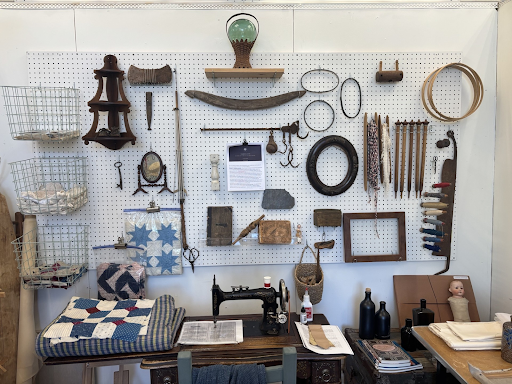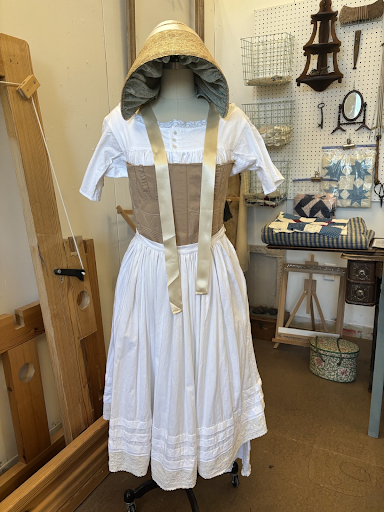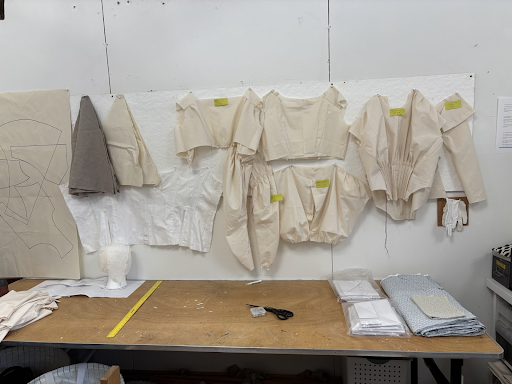MFA Student Emily Smith is Sharing Details about their Thesis Project
Emily Smith, third year MFA Student in Fibers, has been working with traditional craft techniques since childhood. “My mother was always experimenting with different crafts, while my grandmother was an avid quilter. They taught me most of the sewing skills I have, while I learned spinning, weaving, and knitting by hanging out at yarn shops and historic sites, watching people do those.” This passion and love for working with fibers comes from the act of community that is interwoven over the years. “-The family and friends who taught you those skills are with you always. You can feel their presence with you when you work. You are never far from home.”
With it being their third year in the SVS MFA program, Smith is sharing some details on her upcoming thesis that crosses over their previous experience in archaeology. “I used to work as an archaeologist and interpreter at various historic sites and managed a small museum collection. So for my thesis, I’m responding to the recent executive order, “Restoring Truth and Sanity to American History.” I’m looking at textiles of the 19th century that were made by women who were institutionalized for “madness,” who embroidered vivid, subversive narratives documenting oppression, abuse, and scandal onto scraps of cloth and even their own clothing.” Apart of this thesis will be Smith making clothing and textiles from the Indian Removal Act period 1830 and the Fugitive Slave Act period 1850, in which Smith will embroider, stencil, and quilt narratives of past and present which the current administration claims are false or “insane”, causing a danger of these truths in history to be erased. “I find the politics of that period to be very similar to our own political climate: nationalistic, anti-immigrant, expansionist, with lots of reaction against the growing demands by women and Black citizens and Indigenous peoples for autonomy and equal rights. I want to challenge the idea promoted by the executive order that there is only one “true” way to talk about American history, and only one valid national story. I want people to see how police brutality is a continuation of the sanctioned bounty hunters who terrorized the Black population before the Civil War, or how deportation has its roots in the Trail of Tears. These are the tactics our government deploys, over and over, and the executive order is meant to silence the kinds of voices, past and present, which make that known. We can’t treat history like fashion, picking and choosing the things that make us look a certain way and discarding the rest of it because it doesn’t fit or flatter our preferred narrative. And yet, we do.”
Emily Smith over the summer had small sculptures and other artworks on display at the Bingham Gallery for the 2025 Grad Showcase. Smith’s section was titled “Objects for the American Resistance.” The “Objects” were inspired by the work of Cecilia Vicuña, an artist and poet who began making her small precarios as a way of voicing her support for the Chilean resistance to the U.S.-supported coup in her country in the 1970s. Smith talks about her process and emotions while making these pieces. “I needed a way to voice my frustration about the direction my country seems to be taking, against the will of many, and my anger at the impact it is having on my 18-year-old and my students. Until this year I made art that was relatively innocuous, but this was cathartic.” Smith was worried about the threat of censorship and their expressing freedom of speech, delaying posting it on their social media. “Because of the trolling and censorship that is now encouraged by our government, it also feels dangerous. I didn’t post the work to Instagram until the show was almost over, because the political divisions in my own family are such that I didn’t want to insult my parents, who have always been very supportive of my creative endeavors. But at some point, I had to own it. At Quaker Meeting we would say, “the truth will out.””
Smith is also an SVS instructor of Papermaking and Artists Books. Smith shares what they like about teaching incoming and returning students. “They have varying degrees of interest in the techniques, but they always grow their skills in ways they didn’t anticipate. When I encounter the same students in other classes, I get to see how they carry those skills and ideas forward. They are so incredibly, intuitively creative—much more so than I am! Working with students gives me so many more ideas than I would have if I spent all day in my home studio, because they use materials in different ways and ask questions I hadn’t thought about before.” You can find more of Emily's work on their Instagram: @epsfibers


